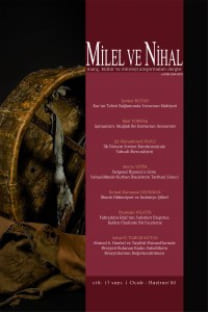Şerh ve Otorite İlişkisi: XVII. Yüzyıla Ait Bir Şerhin Analizi
<!--
/* Font Definitions */
@font-face
{font-family:"Cambria Math";
panose-1:2 4 5 3 5 4 6 3 2 4;
mso-font-charset:0;
mso-generic-font-family:auto;
mso-font-pitch:variable;
mso-font-signature:-536870145 1107305727 0 0 415 0;}
@font-face
{font-family:Calibri;
panose-1:2 15 5 2 2 2 4 3 2 4;
mso-font-charset:0;
mso-generic-font-family:auto;
mso-font-pitch:variable;
mso-font-signature:-536870145 1073786111 1 0 415 0;}
@font-face
{font-family:"BellGothic BT Roman";
panose-1:2 11 5 6 2 2 3 2 2 4;
mso-font-charset:0;
mso-generic-font-family:auto;
mso-font-pitch:variable;
mso-font-signature:3 0 0 0 1 0;}
/* Style Definitions */
p.MsoNormal, li.MsoNormal, div.MsoNormal
{mso-style-unhide:no;
mso-style-qformat:yes;
mso-style-parent:"";
margin-top:0in;
margin-right:0in;
margin-bottom:10.0pt;
margin-left:0in;
line-height:115%;
mso-pagination:widow-orphan;
font-size:11.0pt;
font-family:Calibri;
mso-fareast-font-family:"Times New Roman";
mso-bidi-font-family:"Times New Roman";
mso-fareast-language:EN-US;}
.MsoChpDefault
{mso-style-type:export-only;
mso-default-props:yes;
font-size:10.0pt;
mso-ansi-font-size:10.0pt;
mso-bidi-font-size:10.0pt;}
@page WordSection1
{size:8.5in 11.0in;
margin:70.85pt 70.85pt 70.85pt 70.85pt;
mso-header-margin:35.4pt;
mso-footer-margin:35.4pt;
mso-paper-source:0;}
div.WordSection1
{page:WordSection1;}
-->
Modern bir kavram olan otoritenin farklı türleri bulunmaktadır.
Otoritenin daha çok siyasi bir anlam taşındığı da düşünülmektedir. Ancak yazılı
metinler ve müelliflerin toplumsal alanda yönlendirici, etkileyici ve
belirleyici oldukları da bir vakıadır. Bu itibarla metin ve müelliflerin de dolaylı
surette toplum içinde manevi/entelektüel bir otoritesinin olduğu
söyleyebiliriz. Bu çalışma belirli bir eser ve eserin şerhi üzerinden XVII. Yy.
Osmanlısı’nda metinsel ve paradigmatik otorite ilişkisinin izini sürmeyi
amaçlamaktadır.
Anahtar Kelimeler:
Metin ve otorite, şerh, Nesefi, Karabaş
Relation of Sharh and Authority: Analysis of a Sharh of the 17th Century
<!--
/* Font Definitions */
@font-face
{font-family:"Cambria Math";
panose-1:2 4 5 3 5 4 6 3 2 4;
mso-font-charset:0;
mso-generic-font-family:auto;
mso-font-pitch:variable;
mso-font-signature:-536870145 1107305727 0 0 415 0;}
@font-face
{font-family:Calibri;
panose-1:2 15 5 2 2 2 4 3 2 4;
mso-font-charset:0;
mso-generic-font-family:auto;
mso-font-pitch:variable;
mso-font-signature:-536870145 1073786111 1 0 415 0;}
@font-face
{font-family:"BellGothic BT Roman";
panose-1:2 11 5 6 2 2 3 2 2 4;
mso-font-charset:0;
mso-generic-font-family:auto;
mso-font-pitch:variable;
mso-font-signature:3 0 0 0 1 0;}
/* Style Definitions */
p.MsoNormal, li.MsoNormal, div.MsoNormal
{mso-style-unhide:no;
mso-style-qformat:yes;
mso-style-parent:"";
margin-top:0in;
margin-right:0in;
margin-bottom:10.0pt;
margin-left:0in;
line-height:115%;
mso-pagination:widow-orphan;
font-size:11.0pt;
font-family:Calibri;
mso-fareast-font-family:"Times New Roman";
mso-bidi-font-family:"Times New Roman";
mso-fareast-language:EN-US;}
.MsoChpDefault
{mso-style-type:export-only;
mso-default-props:yes;
font-size:10.0pt;
mso-ansi-font-size:10.0pt;
mso-bidi-font-size:10.0pt;}
@page WordSection1
{size:8.5in 11.0in;
margin:70.85pt 70.85pt 70.85pt 70.85pt;
mso-header-margin:35.4pt;
mso-footer-margin:35.4pt;
mso-paper-source:0;}
div.WordSection1
{page:WordSection1;}
-->
Authority as a modern concept has various types.
It is also thought the authority has a more political meaning. Besides there is
also a fact that texts and writters/authors have played directive, influential
and determinative roles in society. In this respect, we can say that texts and
writters/authors are indirectly spiritual / intellectual authority within
society. The aim of this study is to trace the relation of textual and
paradigmatic authority in the 17th century in the Ottoman Empire over a certain
work and its sharh.
Keywords:
Text and authority sharh, Nasafi, Karabas, al-‘Aqaid,
___
- Abdülhamid, İrfan, İslam’da İtikadi Mezhepler ve Akaid Esasları, çev.: Mustafa Saim Yeprem, Türkiye Diyanet Vakfı Yay., Ankara 2011.
- el-Afîfî, Ebu’l-Alâ, “Mu’tezile’nin Ma‘dum Nazariyesi ile İbn Arabî’nin A‘yân-ı Sabite Nazariyesinin Karşılaştırılması”, çev. Cağfer Karadaş, Uludağ Üniversitesi İlahiyat Fakültesi Dergisi, yıl: 1997, c. 6, sayı: 6, ss. 267-276.
- Arslan, Ahmet, İlkçağ Felsefe Tarihi 4 : Helenistik Dönem Felsefesi: Epikurosçular Stoacılar Septikler, İstanbul Bilgi Üniversitesi Yay., 2. Bsk., İstanbul 2010.
- Bilmen, Ömer Nasuhi, Muvazzah İlmi Kelam, Bilmen Yayınevi, İstanbul 1972.
- Coşkun, İbrahim, “Muhyiddin İbn Arabi’nin Felsefesinde “Allah” Mefhumu”, Tasavvuf: İlmi ve Akademik Araştırma Dergisi (İbnü’l-Arabî Özel Sayısı), Yıl: 9 (2008), sayı: 21, ss. 117-143.
- Çelebi, Kâtip, Mîzânü’l-hak fî ihtiyâri’l-ahak, Haz: Orhan Şaik Gökyay, MEB Yay., İstanbul 1993.
- ISSN: 1304-5482
- Yayın Aralığı: Yılda 2 Sayı
- Başlangıç: 2003
- Yayıncı: Milel ve Nihal: Eğitim, Kültür ve Düşünce Platformu Derneği
Sayıdaki Diğer Makaleler
İsfâhan’da Nizarî-İsmâilî Faaliyetleri
Modern Tanrı-Devletin Tarihöncesi: Hıristiyanlık’ta ve İslam’da İktidar
De Facto Siyasal Otoriteden Meşru Siyasal İktidara: Mâtürîdî’nin Ulu’l-Emr Kavramsallaştırması
Hadislere Göre Yöneticiye İtaatin Sınırları
Osmanlı Devleti’nde Geleneksel Oğuz Veraseti Üzerine
Türk Kültüründe Egemenliğin Dinsel ve Mitolojik Kökleri
Daron Acemoğlu – James A. Robin, Ulusların Düşüşü
İlyas Canikli, Hadislere Göre Yöneticiye İtaatin Sınırları,
Şerh ve Otorite İlişkisi: XVII. Yüzyıla Ait Bir Şerhin Analizi
